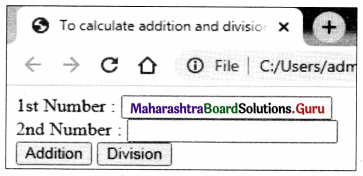Directors and Key Managerial Personnel of a Company 11th Secretarial Practice Chapter 6 Solutions Maharashtra Board
Balbharti Maharashtra State Board Class 11 Secretarial Practice Solutions Chapter 6 Directors and Key Managerial Personnel of a Company Textbook Exercise Questions and Answers.
Class 11 Secretarial Practice Chapter 6 Exercise Solutions
1A. Select the correct answer from the options given below and rewrite the statements.
Question 1.
_____________ comprises of a team of Directors.
(a) Board of Directors
(b) Board of Trustees
(c) Board of Managers
Answer:
(a) Board of Directors
Question 2.
_____________ can be a director.
(a) An Individual
(b) A Firm
(c) A Body corporate
Answer:
(a) An individual
![]()
Question 3.
Upto _____________ as maximum directors are allowed to a company.
(a) five
(b) fifteen
(c) fifty
Answer:
(b) fifteen
Question 4.
A maximum of _____________ Directorships is allowed to a person.
(a) two
(b) ten
(c) twenty
Answer:
(c) twenty
Question 5.
A maximum of _____________ Directorships of a public company is allowed to a person.
(a) one
(b) ten
(c) twenty
Answer:
(b) ten
Question 6.
_____________ is a unique identification number required to be a Director.
(a) PIN
(b) DIN
(c) TIN
Answer:
(b) DIN
Question 7.
_____________ powers are the powers given to Board under the Act.
(a) Statutory
(b) Managerial
(c) Administrative
Answer:
(a) Statutory
Question 8.
Director represents company in his role as _____________
(a) Agent
(b) Managing Partner
(c) employee
Answer:
(a) Agent
![]()
Question 9.
Managing Director is appointed for a period of _____________ years
(a) 5
(b) 10
(c) 15
Answer:
(a) 5
Question 10.
_____________ is required to work under superintendence, control, guidance of the Board.
(a) Government
(b) ROC
(c) Managing Director
Answer:
(c) Managing Director
Question 11.
_____________ is an employee of the company.
(a) Alternate director
(b) Non-executive Director
(c) Whole-time director
Answer:
(c) Whole time Director
Question 12.
_____________ need not be a director of the company.
(a) Manager
(b) Managing Director
(c) Whole-time director
Answer:
(a) Manager
Question 13.
_____________ needs a whole time director.
(a) Listed company
(b) Partnership
(c) OPC
Answer:
(a) Listed company
Question 14.
To provide guidance to Board is _____________ duty of Company Secretary.
(a) Personal
(b) General
(c) Statutory
Answer:
(c) Statutory
Question 15.
Only a member of _____________ can be a practicing Company Secretary.
(a) ICAI
(b) ACCA
(c) ICSI
Answer:
(c) ICSI
![]()
Question 16.
_____________ is to be prepared in prescribed form MR-3.
(a) Annual Report
(b) Auditors Report
(c) Secretarial Audit Report
Answer:
(c) Secretarial Audit Report
1B. Match the pairs.
Question 1.
| Group ‘A’ | Group ‘B’ |
| (a) Board of Directors | (1) Nominated by the Board |
| (b) Managing Director | (2) Assists and advises the Board |
| (c) Company Secretary | (3) Automatic Appointment |
| (d) First Directors | (4) Appointed by ROC |
| (e) Alternate Director | (5) Extensive Powers of management |
| (6) Substantial Powers of management | |
| (7) Appointed by Promoter | |
| (8) Assist and Advises the Government | |
| (9) Negligible Powers of management | |
| (10) Nominated by Council |
Answer:
| Group ‘A’ | Group ‘B’ |
| (a) Board of Directors | (5) Extensive Powers of management |
| (b) Managing Director | (6) Substantial Powers of management |
| (c) Company Secretary | (2) Assists and advises the Board |
| (d) First Directors | (7) Appointed by Promoter |
| (e) Alternate Director | (1) Nominated by the Board |
Question 2.
| Group ‘A’ | Group ‘B’ |
| (a) Public company | (1) Arises due to death of Director |
| (b) Private company | (2) Collective Powers |
| (c) Secretarial Auditor | (3) Individual Powers to Directors |
| (d) Casual Vacancy of a Director | (4) Arises due to additional work |
| (e) Powers of the Board | (5) Appointed by Managing Director |
| (6) At least 2 (two) Directors | |
| (7) At least 3 (three) Directors | |
| (8) At least 15 (fifteen) Directors | |
| (9) At least 1 (one) Director | |
| (10) Appointed by the Board |
Answer:
| Group ‘A’ | Group ‘B’ |
| (a) Public company | (7) At least 3 (three) Directors |
| (b) Private company | (6) At least 2 (two) Directors |
| (c) Secretarial Auditor | (10) Appointed by the Board |
| (d) Casual Vacancy of a Director | (1) Arises due to death of Director |
| (e) Powers of the Board | (2) Collective Powers |
1C. Write a word or a term or a phrase that can substitute each of the following statements.
Question 1.
The organization with distinct features of separate ownership and management.
Answer:
Joint-stock company
Question 2.
The officer is responsible for the company’s finances.
Answer:
Chief Financial Officer
Question 3.
The body of elected representatives of the company.
Answer:
The Board of Directors
Question 4.
The officer is a statutory and administrative officer and also acts as co-ordinator of the company.
Answer:
Company Secretary
Question 5.
Qualification required to be a Company Secretary.
Answer:
Member of ICSI
![]()
Question 6.
Agents, Trustees, and Managing Partners of the company.
Answer:
The Board of Directors
Question 7.
The audit which checks compliances of different legislations.
Answer:
Secretarial audit
Question 8.
This KMP signs documents of the company requiring authentication by the company.
Answer:
Company Secretary
Question 9.
The nature of the relationship of Directors with the company.
Answer:
Fiduciary
Question 10.
Name the Secretarial Standard – 1.
Answer:
Secretarial Standards on meetings of the BOD
Question 11.
Name the Secretarial Standard – 2.
Answer:
Secretarial Standards on General Meeting
Question 12.
Name the Secretarial Standard – 3.
Answer:
Secretarial Standards on Dividend
1D. State whether the following statements are True or False.
Question 1.
A large number of shareholders necessitates the company to have a separate managerial body.
Answer:
True
Question 2.
The maximum number of Directors allowed to a company is 15 (fifteen).
Answer:
True
![]()
Question 3.
A public company should have a minimum of 10 (ten) directors.
Answer:
False
Question 4.
DIN is required for Secretaryship.
Answer:
False
Question 5.
Executive Director is called an outside Director.
Answer:
False
Question 6.
The promoter of a company cannot be the Independent Director.
Answer:
True
Question 7.
Only individuals can be directors.
Answer:
True
Question 8.
The casual vacancy of the Board is filled by the members.
Answer:
False
Question 9.
To function as per Articles of Association of the company is the statutory duty of the Board.
Answer:
True
Question 10.
A Director is an employee of the company.
Answer:
False
Question 11.
The Managing Director is appointed by a resolution.
Answer:
True
Question 12.
The minimum and maximum age to be a Managing Director is 21 and 70 respectively.
Answer:
True
![]()
Question 13.
A company may appoint more than one M.D.
Answer:
True
Question 14.
Indian companies prefer a Managing Director over a Manager.
Answer:
True
1E. Find the odd one.
Question 1.
Woman Director, Promoter, Executive Director.
Answer:
Promoter
Question 2.
Absent at Board Meeting, failure to disclose an interest, DIN.
Answer:
DIN
1F. Complete the sentences.
Question 1.
Separate ownership and management is a unique feature of _____________
Answer:
Company
Question 2.
Minimum number of Directors for a private company should be _____________
Answer:
Two
Question 3.
Minimum number of Directors for a public company should be _____________
Answer:
Three
Question 4.
Minimum number of Directors for an OPC should be _____________
Answer:
One
![]()
Question 5.
First Directors of a company are appointed by _____________
Answer:
Promoter
Question 6.
At least one Woman Director is required by _____________ company.
Answer:
Listed Company
Question 7.
Casual vacancy on Board is filled by _____________
Answer:
Board
Question 8.
Director is the guardian of interest of company as _____________
Answer:
Trustees
Question 9.
First Secretary is appointed by _____________
Answer:
Promoters
Question 10.
The audit which checks the compliance of Companies Act is called as _____________
Answer:
Secretarial Audit
1G. Select the correct option from the bracket.
Question 1.
| Group ‘A’ | Group ‘B’ |
| (1) Rotational Director | ………………….. |
| (2) ………………………. | Alternate Director |
| (3) Woman Director | ………………….. |
| (4) ………………………. | First Director |
(Every Listed Company, Appointee by Promoters, Appointed in Place of a director who is absent, Retire by Rotation)
rotation)
Answer:
| Group ‘A’ | Group ‘B’ |
| (1) Rotational Director | Retire by Rotation |
| (2) Appointed in Place of a director who is absent | Alternate Director |
| (3) Woman Director | Every Listed Company |
| (4) Appointee by Promoters | First Director |
1H. Answer in one sentence.
Question 1.
Who is the officer responsible for the company’s financial plan?
Answer:
Chief Financial Officer is responsible for the company’s financial plan.
Question 2.
What is the importance of Secretarial Standards?
Answer:
The main aim of Secretarial Standards is to standardize all diverse secretarial practices prevailing in the corporate world.
![]()
Question 3.
Who provides guidance to the Board of Directors?
Answer:
Company Secretary provides guidance to the Board of Directors.
Question 4.
What is the tenure of ‘Managing Director?
Answer:
The tenure of the Managing director is Five Years.
1I. Correct the underlined word and rewrite the following sentences.
Question 1.
A public company must have a minimum of 15 directors.
Answer:
A public company must have a minimum of 03 directors.
Question 2.
First Directors are appointed by ROC.
Answer:
First Directors are appointed by Promoters.
Question 3.
Secretarial Standards are given by the Companies Act, 2013.
Answer:
Secretarial Standards are given by the Institute of Company Secretaries of India.
2. Explain the following terms/concepts.
Question 1.
Director
Answer:
Director is a person appointed to manage, direct and supervise the company. According to Sec-2(34) of the act, “Director means a director appointed to the Board of the company”.
Question 2.
Managing Director
Answer:
Managing Director is a director appointed by virtue of an agreement with the company; or by passing a resolution in the general meeting or by its Board of Directors or by virtue of Memorandum of Associations or Articles of Association. He is entrusted with substantial powers of management of the affairs of the company. He is appointed for a period of 5 years.
![]()
Question 3.
Independent Director
Answer:
As per section 149 of the Companies Act, 2013, any director other than a managing director, whole-time director, or a nominee director is termed as an independent director.
Question 4.
Executive Director
Answer:
Executive Director is also called as ‘Whole Time Director’, He is in full-time employment with the company. He plays an important role in the day-to-day management of the company.
Question 5.
Non-Executive Director
Answer:
Non-Executive Director is known as ‘Outside Director’. Non-Executive Director is not involved in the day-to-day management of the company. He is appointed to get second opinions from the board.
Question 6.
Alternate Director
Answer:
Alternate Director is a director who is nominated by the board in the place of absence director. He is appointed for a minimum of 3 months.
Question 7.
Casual vacancy of Director
Answer:
The casual vacancy is created due to the death of a director, which is filled by the board at the board meeting. It is valid till the vacating director’s incomplete term.
Question 8.
Chief Financial officer
Answer:
An officer responsible for the company’s finances is called Chief Financial Officer. He need not be a director of the company. He has to compulsory sign the audited financial statements of the company.
Question 9.
Company Secretary
Answer:
The company secretary is appointed to perform functions of the company and he is appointed by a resolution of the Board. He has to follow the terms and conditions decided by the board. He should be a member of ICSI.
Question 10.
Secretarial Standard
Answer:
It is formulated by ICSI and approved by Central Government through the Ministry of Corporate Affairs (MCA). The main purpose of setting Secretarial Standards is to standardized fine corporate government practices prevailing in companies.
![]()
Question 11.
Secretarial Audit
Answer:
It is an audit that monitors the compliance requirements of the company. The main aim of such an audit is to detect errors and mistakes in compliance with the rules and regulations of the Companies Act. It builds confidence among regulators, management, and shareholders of the company.
Question 12.
The Board of Directors
Answer:
Representatives elected by the Equity Shareholder in their Annual General Meeting are called as Board of Directors. They are allotted certain powers to control and manage the business of the firms.
3. Study the following case/situation and express your opinion.
1. Mr. A is a commerce graduate. He has vast experience in the field of finance and the financial market. He wishes to become a director of PQR Co. Ltd.
Question (a).
Is he required to obtain DIN?
Answer:
He was required to obtain DIN. It is compulsory to acquire DIN for every Director.
Question (b).
Can PQR Co. Ltd. object to his directorship on lack of specialized qualification?
Answer:
The company act has not prescribed any academic or professional qualification for directors, so he can obtain directorship.
Question (c).
If he is appointed as director of PQR Co. Ltd, is he entitled to remuneration?
Answer:
The managerial position entitles him to get managerial remuneration so if Mr. A is appointed as director of PQR Co. Ltd then he is entitled to remuneration.
2. Mr. Z is a member of the Institute of Company Secretaries of India.
Question (a).
Can Mr. Z be appointed as pro-tem Secretary of LMN Ltd. which is under formation?
Answer:
Yes, Mr. Z can be appointed as pro-tem secretary of LMN Ltd. which is under formation. The First Secretary is appointed by the promoters of the company.
Question (b).
Can Mr. Z work as Secretarial Auditor?
Answer:
Yes, Mr. Z can work as Secretarial Auditor because he is a member of ICSI.
Question (c).
Mr. Z wishes to be employed as whole time Secretary in companies ABC Ltd. and OPC Ltd. Is he allowed?
Answer:
Mr. Z, as a whole-time secretary, cannot hold office in more than one company. So, Mr. Z can be employed either in ABC Ltd or One Person Company and not in both.
![]()
3. Mr. M wishes to be the Managing director of QRS Ltd.
Question (a).
The age of Mr. M is 30 years. Can he be appointed as MD of a company?
Answer:
Yes, Mr. M is 30 years old and the age required to be completed for MD’s post is 21 years. So he can be appointed as MD of a Company.
Question (b).
Is it necessary that Mr. M should be one of the directors on the Board of QRS Ltd?
Answer:
Yes, It is necessary that Mr. M should be one of the directors on the board of QRS Ltd. He should be appointed by the board.
Question (c).
For how long a period QRS Ltd. can appoint Mr. M. as a Managing Director?
Answer:
QRS Ltd can appoint Mr. M. as a managing director for a period of 5 years.
4. Distinguish between the following.
Question 1.
Director and Managing Director
Answer:
| Basis | Director | Managing Director |
| 1. Meaning | Director is the elected representative of the shareholders of the company. | The managing director represents the board in the day-to-day activities of the business. |
| 2. Appointment | He is elected at the Annual General Meeting by the members of the company. | He is appointed by the board of directors. |
| 3. Tenure | Directors of public companies retire by rotation. Maximum tenure is of 3 years, 1/3 of Independent Director is not liable to retire by rotation. | The tenure of managing director is for a term of five years. |
| 4. Remuneration | Remuneration for services is given as per specific provisions. The director is given sitting fees to attend the board meeting which may extend up to ₹ 1 lakh plus remuneration. | M.D is entitled to either a monthly salary or 5 % of the net profit. If more than one M.D. is appointed then maximum remuneration cannot be more than 10% of the net profit. |
| 5. Status | Directors are elected representatives of the shareholders managing company in absence of shareholders. They can be agents of the company but not employees of the company. | Managing Director has dual status i.e. a director and a manager (employee). |
| 6. Positions held | Director is the only member or person on the board. | The managing director is the director on the Board. M.D. is the whole time manager in the company. |
| 7. Number of companies | Director can work in 20 companies at a time wherein a maximum of 10 public companies at a time. | A person can be an M.D. of a maximum of 2 companies at a time. |
Question 2.
Managing Director and Manager
Answer:
| Basis | Managing Director | Manager |
| 1. Meaning | The Managing Director is appointed by the Board to look after the day-to-day administration of the company. | The manager is in charge of the whole management affairs of the company. |
| 2. Appointment | The managing director is appointed by an agreement with the company or by resolution passed by the company in a Board meeting or by virtue of its Articles of Associations of the company. | The manager is appointed under a contract of service. |
| 3. Remuneration | MD is entitled to either a monthly salary or 5% of net profit. If there is more than one managing director, the maximum remuneration payable is 10% of the net profit. | Maximum remuneration to a manager cannot be more than 5% of the net profit. |
| 4. Number of posts | A company may have more than one Managing Director. He can be M.D. in maximum of 2 companies. | The company can have only one post of manager. |
| 5. Power | He is given substantial powers of management. | He is entrusted with whole powers of management. |
| 6. Position held | The managing director must be the director of the company. | The manager need not be a director of the company. |
Question 3.
Managing Director and Whole Time Director
Answer:
| Basis | Managing Director | Whole Time Director |
| 1. Meaning | The managing director represents the board in the day-to-day management of the company. | The whole time director devotes whole time to the working of the company. |
| 2. Powers | The Managing Director is given substantial powers of management. | A whole-time director does not have the power to take decisions on policy matters. |
| 3. Number of posts | A person can be an M.D. of a maximum of 2 companies at a time. | More than one whole-time directorship is not possible at a time. |
| 4. Performance | He manages the affairs and business of the company. | He performs important administrative functions of the company. |
5. Answer in brief.
Question 1.
What is DIN?
Answer:
- It means Director Identification Number.
- DIN is a Unique Identification Number for an existing director or person intending to be the director of a company.
- It is compulsory to acquire DIN by Director.
- It helps in the detection and handling of offenses committed by a director.
- It is obtained through an online process by filing an application.
![]()
Question 2.
State any four powers of the Board of Directors.
Answer:
- Director is a person appointed to manage, direct and supervise the affairs of the company.
- The power of the Board of Directors are as follows:
- To appoint or remove key managerial personnel: The Board of Directors has the power to appoint and remove key managerial personnel.
- To recommend dividend: The board of directors recommends the dividend to the shareholders.
- To fill a casual vacancy in the Board: Casual vacancy in the board arises due to different reasons such as the death of a director who is filled by the Board at the Board meeting.
- To issue securities whether in India or abroad: Board of Director’s issue securities means shares, debentures, bonds) in India and abroad also.
Question 3.
Mention any four ways in which the office of a director becomes vacant.
Answer:
The office of a Director shall automatically become vacant in the following ways:
- Any disqualification: A person cannot be appointed as a director if he is of unsound mind or insolvent or convicted by the court.
- Absentee at Board meeting: Director who has been absent in the meeting of the board of directors held during the period of 12 months with or without taking leave of absence of the Board.
- Disqualification by Court or Tribunal: Director has to vacate office if he has been disqualified by an order of a court or the Tribunal.
- Provision of the Act: Director has to vacate office if he is removed under the provisions of the Companies Act.
Question 4.
State the powers of a Managing Director.
Answer:
As it is stated in the definition itself the Managing Director is entrusted with the substantial powers of management, which clearly indicates that he has been given certain important powers of routine business matters of a company.
The powers exercised by him are fellows:
- To act as a link between the Board of Directors and the managerial staff.
- To look after the management and administration of a company.
- To appoint the company employees.
- To participate in policymaking as well as policy execution.
- To sign contracts on behalf of a company.
- To decide about the investment of funds of a company.
- To receive remuneration from a company.
Question 5.
State the statutory duties of a company secretary.
Answer:
Secretary is an employee of the company. He enjoys the power and advises the management.
Statutory duties of a company secretary are as follows:
- To organize meetings and be present at all the meetings of the company.
- To maintain the minutes of all meetings.
- To issue notices and circulars to the members of the company.
- To maintain and update the Register of members and debenture holders and other books of the company.
- To file all necessary returns with the Registrar of Companies.
- To communicate with the shareholders on various matters.
![]()
6. Justify the following statements.
Question 1.
Directors are managing partners.
Answer:
- Directors have to work as a team as Board of Directors, not as an individual.
- The powers by Board are subject to provisions of the Companies Act and Memorandum and Articles of Associations.
- Director is required to perform his functions.
- He represents shareholders to conduct and manage the business of the company on their behalf.
- They are entrusted with vast powers of management and perform several functions which are proprietary in nature like allotment of shares, raising of loans, investing funds of the company.
- This is because they themselves are significant shareholders of the company.
- In fact, they are the most active shareholders of the company.
- Thus, Directors are the managing partners of the company.
Question 2.
A Director is an agent of the company.
Answer:
- Since the company is an artificial person, it needs to be represented by the Director.
- They deal on behalf of the company.
- Directors should deal skillfully, carefully, and diligently.
- Directors are held liable as an, while company is held liable as the principal.
- A Director is an agent as he acts between the company and shareholders.
- Thus, a director is an agent of the company.
Question 3.
The company has a distinct feature of separate ownership and management.
Answer:
- The company has a unique feature of separate ownership and management.
- Shareholders are its owner and Directors are its managers.
- Being an artificial person, it needs a human agent to manage and control the working of the company.
- Shareholders are scattered all over therefore management of the company by them is not possible.
- Also, the shareholders are not interested in the management of such a big organization.
- The company as an artificial person having no physical existence needs humans to control its affair.
- Thus, the company has a distinct feature of separate ownership and management.
![]()
Question 4.
DIN helps investors of the company.
Answer:
- DIN is a unique identification number for an existing director or person intending to be the director of the company.
- It is compulsory to acquire DIN by every Director.
- Din is Pre-require for e-filling of company’s documents.
- It helps the investors of the company to make a more accurate and informed decisions because they get to known the composition of the top management of the company.
- It also helps to handle the problems created due to a company after collecting or raising money from the public.
- Thus, I agree with the given statement.
Question 5.
Directors have to work as a team.
Answer:
- Directors have to work as a team of “Board of Directors” and not individually.
- He exercises the power as a Board which is subject to provision of the Act.
- Director is a representative of shareholders so he has to work collectively in the best interest of the company and its shareholders.
- He cannot take decisions alone on behalf of the company.
- Thus, directors have to work as a team.
Question 6.
Directors play a triple role.
Answer:
- Directors play a triple role i.e. in the form of an agent, as a managing partner, and as a trustee.
- As an agent, the director deals skillfully, carefully, and elegantly while representing the company with outsiders.
- As a managing partner, the director acts as a representative of the shareholder and manages the company on their behalf.
- As a trustee, the director acts as a guardian of the interest of shareholders and a company.
- They use the company’s funds in the most appropriate manner and cautiously.
- They are also the trustee of all the assets of the company.
- Thus, directors play a triple role.
Question 7.
Company Secretary plays a triple role.
Answer:
- Company Secretary plays a three-fold role in the form of – as a statutory officer, as a coordinator, and as an administration officer.
- As a statutory officer, the secretary signs the document for authentication, files annual returns to ROC, maintains various statutory registers and ensures compliance with the law.
- As a coordinator, the secretary acts as a network between the Board of Directors and other executive officers at different levels. He acts as an internal as well as external coordinator for the company.
- As an administrative officer, the secretary ensures the implementation of various policies of the company and also supervises and controls the functioning of various departments of the company.
- Thus, Company Secretary plays a triple role.
![]()
Question 8.
A director cannot be called an employee of the company.
Answer:
- Directors are elected representatives of the company’s shareholders.
- The status of an employee is within the limits of his contract and service.
- His employer holds the ultimate control to guide his activities and functions.
- These limits of an employee cannot be applied to a director.
- So a director cannot be called an employee of the company.
- Thus, a director cannot be called an employee of the company.
Question 9.
The managing Director has substantial powers of management.
Answer:
As it is stated in the definition itself the Managing Director is entrusted with the substantial powers of management, which clearly indicates that he has been given certain important powers of routine business matters of a company.
The powers exercised by him are as follows:
- To act as a link between the Board of Directors and the managerial staff.
- To look after the management and administration of a company.
- To appoint the company employees.
- To participate in policymaking as well as policy execution.
- To sign contracts on behalf of a company.
- To decide about the investment of funds of a company.
- To receive remuneration from a company.
Question 10.
Indian companies prefer to appoint a Managing Director than a Manager.
Answer:
- Indian company prefers to appoint managing director rather than manager because Managing Directors holds dual authorities and he is able to influence the board of director in a better way.
- Manager need not be a director of a company while the managing director has to be director of a company,
- The company cannot have more than one manager, while it can have more than one managing director.
- Thus, Indian companies prefer to appoint a managing director than a manager.
Question 11.
Pro-tem secretary is helpful to the company.
Answer:
- The first secretary of the company is appointed by the promoters of the company.
- The first secretary is called as ‘pro-tem’ secretary.
- Pro-tem secretary appointed by promoters may or may not be appointed as full-time or regular Secretary.
- Pro-tem secretary helps in fulfilling different formalities during the formation of the company.
- Thus, the Pro-tem secretary is helpful to the company.
Question 12.
Secretarial Standards should be in conformity with the Act.
Answer:
- The Secretarial Standards are formulated by the Institute of Company Secretaries of India and approved by the Central Government through the Ministry of Corporate Affairs.
- The Companies Act, 2013, makes compliance with the Secretarial Standard mandatory.
- It leads to provide better monitoring of compliances of law, strengthening the process of the Board, and create confidence in investors.
- The Secretarial Standards aim at achieving integrating, harmonizing, and standardizing fine corporate governance practices across all companies.
- Thus, Secretarial Standards should be in conformity with the Act.
![]()
Question 13.
Secretarial Standards lead to better legal compliance.
Answer:
- Companies follow diverse practices based on differing business cultures and varied usages over a period of time.
- The Secretarial Standards aim at achieving integrating, harmonizing, and standardizing fine, corporate governance across all companies
- It leads to provide better monitoring of compliance of the law, strengthening the process of the Board, and create confidence in investors.
- Secretarial Standards are reviewed by Secretarial Standard Board (SSB) once a year or whenever changes are made in the law.
- Thus, Secretarial Standards lead to better legal compliance
Question 14.
A secretarial Audit is required under the laws.
Answer:
- It is an audit that checks the compliance of various legislation including the Companies Act, other Corporate Acts, and economic laws.
- It aims at detecting errors and mistakes in the compliance mechanisms.
- It gives confidence to regulators, management authorities, and shareholders that the company is following a disciplined approach of evaluation and improve effectiveness and risk management.
- Thus, Secretarial Audit is required under the laws.
7. Answer the following questions.
Question 1.
Explain the Role of Directors.
Answer:
Director is a person appointed to manage, direct and supervise the affairs of the company.
The elected representatives of the shareholders are called Directors.
Role of the Directors:
- He helps the investors to take accurate decision.
- He has to fill casual vacancies on the board.
- He has to recommend dividends.
- He has to issue securities in India or abroad.
- He manages a company on behalf of the shareholder.
- He appoints the first auditor of the company.
- He can appoint or remove Key Managerial Personnel.
- He can borrow the money on behalf of the company.
- His role is full of trust, loyalty, care, and good faith.
- Directors act as a trustee, agent and managing partner for the company.
Question 2.
Explain the duties of a Director.
Answer:
A director’s relationship with a company is regarded as fiduciary in nature. It means his duty is full of trust, care, and good faith.
The duties of directors can be categorized into two heads:
- Statutory Duties:
- To file a return of Allotment.
- To act in accordance with the Articles of the company.
- To disclose an interest in a transaction.
- To attend Board meetings.
- To appoint first Auditors of the company.
- General Duties:
- Duty of good faith i.e. he must act in the best interest of the company.
- Duty of care i.e. he must take utmost care in the performance of work assigned.
- Duty not to delegate i.e. he is required to perform his function personally. He may delegate in case of emergency.
![]()
Question 3.
Explain the Managing Director.
Answer:
Definition: The Companies Act, has defined a Managing Director as “A Director who by virtue of an agreement with the company or of a resolution passed by a company in the general meeting or by its Board of Directors or by virtue of its Memorandum or Articles of Association, is entrusted with substantial powers of management of the company”.
Disqualification:
- Any person less than 21 years of age and more than 70 years of age.
- A person who is an undischarged insolvent person or has at any time been adjudged as an insolvent.
- A person who has suspended payment to his creditors or made a composition with them.
- A person who is, or has been convicted by a court of an offense with a sentence of more than 6 months period.
Appointment:
A Managing Director may be appointed by any one of the following ways:
- by an agreement with a company.
- by the resolution passed at the general meeting.
- by the Board of Directors.
Term of office:
The term of office of the Managing Director cannot exceed 5 years at a time, but he can be reappointed as such for a further period of five years.
The number of Managing Directorship:
A Managing Director can not act as such for more than two companies at the same time.
Remuneration:
The remuneration paid to the Managing Director is subject to the maximum limit of 5% of the net profit of a company or a monthly salary. If a company has more than one Managing Director then total remuneration paid to them (all) shall not exceed 10% of the net profit.
Powers of a Managing Director:
- To act as a link between the Board of Directors and the managerial staff.
- To look after the management and administration of a company.
- To appoint the company employees.
- To participate in policymaking as well as policy execution.
- To sign contracts on behalf of a company.
- To decide about the investment of funds of a company.
- To receive remuneration from a company.
Duties of a Managing Director:
- To act on behalf (agent) of the Board of Directors.
- To implement the decision of the Board.
- To supervise, direct, control, and guide the day-to-day affairs of the business.
- To guide the senior executives in their administrative work.
- To report to the Board about programmes made or any problem faced by a company.
- To chair the Board meetings and general meetings, if necessary.
- To manage routine work of a company.
- To sign all the contracts and documents on behalf of the company.
Question 4.
Explain the Company Secretary.
Answer:
Meaning:
- Secretary is an employee of the company and he is appointed to perform functions of a company secretary,
- He should be a member of the Institute of Company Secretaries of India (ICSI).
- The first secretary is appointed by the promoter of the company and he is called a ‘pro-tem’ secretary.
- He holds liable for non-compliance with the provisions of the Act.
Duties of a Company Secretary:
It is categorized as (A) Statutory Duties and (B) General Duties.
(A) Statutory Duties:
- To organize and attend meetings of the company.
- To prepare minutes of meetings.
- To communicate with shareholders on various matters.
- To issue notices and circulars to the members of the company.
- To maintain various Registers and books of the company
- To file returns with the ROC.
(B) General Duties:
- To provide guidance to the Board of Directors as needed.
- To discharge duties towards regulators and authorities of the company.
- To assist the Board of Directors in conducting the business of the company.
- To perform duties allotted by the Board.
Rights of a Secretary:
- To control and supervise the working of departments of the company.
- To get indemnified by the company, if any loss is suffered by the secretary.
- To sign documents requiring authentication.
- To get remuneration from the company.
![]()
Question 5.
Explain the role of the Company Secretary.
Answer:
The company secretary plays a crucial and important role in the administration of the company.
The emphasis on good governance has increased the role of the secretary in protecting the interest of investors.
Role of Company Secretary:
- Secretary as a Statutory officer:
- To sign documents for authentication.
- To sign and deliver Annual Returns and other documents and to the Registrar of Companies.
- To maintain different statutory registers like
- Minutes of General and Board meetings of the company.
- Registers of Members and Debenture holders Register of Directors and KMP and their shareholdings.
- To ensure compliance with the law
(ii) Secretary as a Co- ordinator:
- To implement policies framed by the Board.
- To act as a link between the Board and other executives at different levels.
- To act as a mouthpiece or spokesperson of the Board.
- To act as an internal and external coordinator.
(iii) Secretary as an Administration officer:
- To ensure implementation of the policies of the company.
- To supervise and control the functioning of different departments of the company.
- To take an overall view of different aspects of the company’s administration and develop a strong and efficient organizational setup.
- To contribute to the administration of the company.
Class 11 Secretarial Practice Textbook Solutions
- Secretary Class 11 Secretarial Practice
- Joint Stock Company Class 11 Secretarial Practice
- Formation of a Company Class 11 Secretarial Practice
- Documents Related to Formation of a Company Class 11 Secretarial Practice
- Members of a Company Class 11 Secretarial Practice
- Directors and Key Managerial Personnel of a Company Class 11 Secretarial Practice
- Company Meetings – I Class 11 Secretarial Practice
- Company Meetings – II Class 11 Secretarial Practice
- Business Communication Skills of a Secretary Class 11 Secretarial Practice
- Correspondence with Directors Class 11 Secretarial Practice
- Correspondence with Banks Class 11 Secretarial Practice
- Correspondence with Statutory Authorities Class 11 Secretarial Practice






























